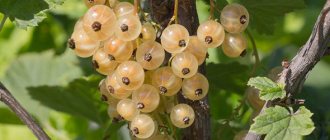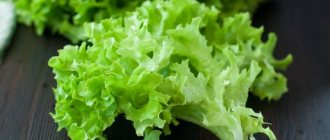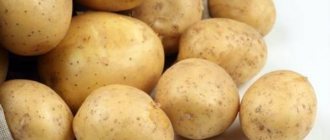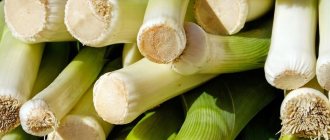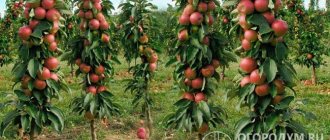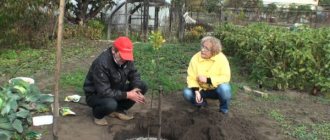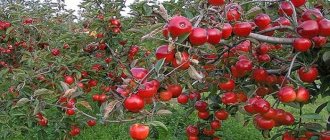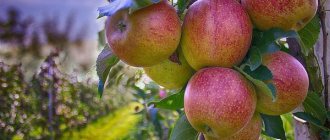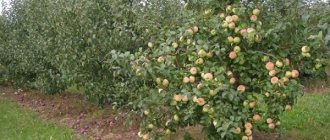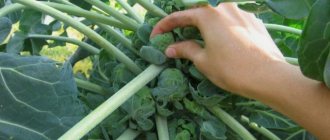Over the last half century, growing apple trees on various rootstocks has become very popular, which makes it possible to further expand the scope of growing apple trees, since not everyone is happy to see large tall trees in tiny areas. And dwarf and semi-dwarf rootstocks allow even owners of six-acre dachas to have several varieties of apple trees in their gardens.
Particularly interesting, from this point of view, are the so-called columnar apple trees. After all, these apple trees almost do not form ordinary side branches, and the fruits ripen directly on the trunk. Of course, it is difficult to pass by such a miracle without admiring it. But they should not be confused with dwarf apple trees. Because columnar varieties arose as a result of a mutation that was caused by a lack of growth hormone. By fixing this mutation, breeders are able to create special columnar varieties of apple trees and other crops. Such varieties have many advantages - they practically do not need pruning, they are compact, beautiful, quite productive, winter-hardy, and even on a small piece of land you can plant several varieties with different ripening periods at once.
The columnar Medoc apple tree is one of the most popular varieties, description, photos and reviews of which you can study in this article. It has many of the advantages of columnar varieties and is even devoid of some of the disadvantages inherent in them. But first things first.
History of selection
Columnar apple trees appeared as a result of natural mutation and the attentiveness of a gardener who noticed a strange branch on a tree, on which apples grew densely, in one row. There were no lateral shoots on it, and it was all covered with leaves. The desire to experiment gave an amazing result; apple trees were created that have a number of distinctive features, but the taste of the fruits is not inferior to traditional ones.
The Medoc variety was obtained at the Institute of Horticulture in 1987 through sowing seeds, and in 1996 it was entered for propagation. The creation of the apple tree was carried out by Professor V.V. Kichina in collaboration with N.G. Morozova.
Apple tree variety Medoc (columnar apple tree)
Medok is a columnar-type apple tree variety with fruits of early autumn (according to some sources - late summer) ripening period, obtained at the Institute of Horticulture (VTISP, Moscow) in 1987 through sowing seeds from free pollination of the columnarity donor KV 103. In 1993, a new variety was selected under number 385/342, and in 1996 the variety under the official name Medoc entered for propagation. All work on creating the variety was carried out by Professor V.V. Kichina in collaboration with N.G. Morozova.
The trees are natural semi-dwarf trees and have a powerful growth force; this apple tree is most successful on dwarf rootstocks 62−396 and Mark. The apple trees are medium-sized, have a columnar shape up to 2 - 2.2 meters high, the crown is characterized by compactness and small dimensions, its width is approximately 20 - 25 cm. The root system is strong and very dense, so the trees tolerate transplants well, both in autumn and spring and are not susceptible to diseases.
The fruits are medium to large in size; the weight of one apple can reach from 100 to 250 grams. It should be borne in mind that the size of the fruit is determined not only by the age of the trees, but also in many respects by proper care of them, watering regime and the application of organic fertilizers. The shape of the apples is round, the skin is dense. The color of the fruit is a pleasant white-yellow, without any outer color.
The pulp is white, very juicy, slightly aromatic, with a coarse-grained structure. The taste qualities are confirmed by the name of the variety: apples have a pleasant sweet taste with a pronounced honey flavor. The fruit ripening period occurs at the end of August - beginning of September. Apples are stored for a short period of time - no more than one month. The purpose of the apple tree is universal - consumption of fresh fruits, all types of home processing.
The Medoc apple tree has a high early fruiting rate: the first fruiting is possible already in the year of planting, if the last one is carried out in the spring. Trees gain maximum yield in the 5th year of growth. The average yield is 5 - 9 kg of very large fruits per tree (or from 80 to 100 tons per hectare). Intensive tree care can double yields.
The frost resistance of the variety is very high; apple trees can withstand temperatures down to minus 42 °C without freezing. Honey is recommended for cultivation in the conditions of the Middle Zone, Moscow region and even Siberia. Its trees can be safely planted in frost-prone areas where Antonovka apple trees suffer from severe freezing. With all this, the fruits have time to fully ripen and gain sweetness. The variety's resistance to pests and diseases is not inferior to the level of the best standard varieties intended for cultivation in the Moscow region.
Description and characteristics of the variety
Medok is a columnar apple tree of late summer or early autumn ripening, with powerful growth force. The tree is medium-sized with a compact crown, medium in width. It has a strong fibrous root system that can tolerate spring and autumn planting well. The fruits are yellowish-white with a honey aroma and sweet taste, each weighing from 100 to 200 grams.
Advantages and disadvantages
Medok is a variety of columnar apple tree with sweet fruits.
The apple tree has received recognition from gardeners for a number of advantages that are worth noting:
- early onset of fruiting;
- resistance to diseases and pests;
- compactness;
- good resistance to sub-zero temperatures.
The disadvantage is the short lifespan of the tree and the high price of seedlings, but this is not so significant, given so many advantages, and is typical for all columns.
Dimensions of an adult tree
The apple tree is formed into one trunk without side shoots, reaching a height of
2.2 meters. The volume of the trunk-column usually grows 50 cm.
Annual growth
Every year the tree grows by 10-15 cm. If the apical bud is damaged, then it needs to be replaced with a lateral one, and this takes some time.
Tasting assessment
The apple pulp is tender, grainy, juicy, sweet with a honey aroma and taste. It is used for preparing dietary dishes, as it requires the addition of a small amount of sugar.
The fruit size of the Medoc variety can reach 250 grams.
Winter hardiness
The Medok variety is quite resistant to frost and is recommended for planting in Siberian conditions. To protect the root system, the tree trunk circle is mulched, the plant is covered with snow, and the trunk is whitened. These procedures will protect the plant from freezing.
Disease resistance
Apple trees are quite resistant to diseases, but they can get sick if a source of infection appears in the garden.
Timely preventive measures and removal of damaged leaves and fruits will help resist infection that may occur on other plants on the site.
Fruit characteristics
The original appearance of the tree, strewn like a column from top to bottom with fruits, will not leave any gardener indifferent. Well, what about the apples themselves, does it make sense to grow them, or can the tree be used more for decorative purposes?
Medoc apples have the following characteristics:
- The fruits cannot be classified as small, on average their weight is 150-200 grams, but there are individual specimens weighing up to 250 grams. The size of the fruit depends not so much on the age of the tree, but on the appropriate care for it: properly organized watering and fertilizing.
- Apples have a round shape.
- The fruits have a fairly uniform rich white-yellow color, without spots or streaks.
- The pulp is juicy, white, and has a coarse-grained structure.
- The name of the variety itself speaks of the high taste qualities of apples. The sweet fruits have a pronounced taste of honey. The aroma is light, almost imperceptible.
- The shelf life of fruits, like most summer varieties, is short - about a month.
- The Medoc variety is universal in use - it is good both fresh and in the form of numerous preparations for the winter.
Features of ripening and fruiting
Columnar apple trees have their own characteristics that need to be taken into account when choosing a variety for planting on your site.
How the columnar apple tree blooms.
Precociousness
The Medoc apple tree, like most of this species, begins to bear fruit in the second year after planting.
Frequency of fruiting
The tree is distinguished by its annual stable fruiting. But if flower buds freeze, there may not be a harvest for one season.
Fruit ripening time
The apples ripen at the end of August and are immediately ready to eat. But the timing may depend on weather conditions at this time and will last until mid-September.
Strengths and challenges
Experts especially highlight the compactness of the crown, large-fruitedness, high yield and frost resistance in the variety, which make it possible to widely use “Medok” as a complex donor in the selection of new columnar forms of apple trees. Valuable qualities also include plant resistance to pests and diseases, and high decorativeness.
Decorative columnar apple trees, planted along a path or near a fence, fit perfectly into the landscape design of even a small garden
Significant problem areas of the variety include: low transportability and short shelf life of fruits, as well as a short period of active fruiting for apple trees and the high cost of seedlings.
Features of fruiting
Columnar apple trees have no branches; fruit formations are located directly on the trunk and alternate from year to year. After 15-17 years, the formations die off, such a tree must be replaced, since it will live, but will not bear fruit.
Productivity
Sweet fruits Medoc.
The average yield is 5-10 kg per tree, the maximum yield that an adult tree can sustain is 15 kg. From one hectare of plantings you can get 100 kg/ha of apples.
Fruit storage
Apples can be stored for no more than a month, but they are suitable for processing. They make delicious compotes, jam, and marmalade.
The fruits are very sweet and are used to make purees for baby food without added sugar, products for diabetics and those struggling with excess weight.
Aftercare for the apple tree
According to reviews, the Medok columnar apple tree requires the same care as ordinary trees. It is important for the fruit crop to provide watering, otherwise there is a risk of reduced yield. The water requirement for an apple tree is 2 buckets. The frequency of watering depends on the weather and soil conditions. According to the standard, the procedure is carried out 2 times a week. The first year after planting, the soil around the apple tree is loosened, mulched, and weeds are removed. In the second year, the ground up to the trunk can be sown with grain crops. Aromatic herbs and strawberries are suitable.
The Medok variety loves feeding in the spring. First, nitrogen fertilizer is applied. When fruiting begins, the apple tree is fed with phosphate and potassium. Organic matter is added to mineral fertilizers. The tree is topped with a solution of slurry 1:10 or bird droppings 1:30. The foliage is sprayed with a urea solution three times a season.
Tree pruning must be approached wisely so as not to destroy its columnarity. The trunk of the apple tree is densely overgrown with fruit branches, which interfere with the development of side shoots. In spring, the branches are cut off, leaving up to 3 fruit buds. In order for the apical bud to ripen faster, from August 15, 2/3 of the four upper leaves are cut off with scissors. When the apical bud freezes, the underlying shoots are left to grow. From these, the strongest branch is selected for the new trunk. All other shoots are pruned.
In the video you can see the correct pruning of a Medoc apple tree:
In late autumn, the crop is prepared for wintering. To protect the roots from freezing, the soil is covered with a 10 cm thick layer of mulch. The apple tree trunk is wrapped with warm material, and spruce branches are tied on top. The spines of the needles will protect the bark from rodents.
Landing Features
Columnar apple trees have a fibrous root system that is located close to the surface of the earth. Thanks to this feature, with normal watering, it takes root well after planting.
Choose a sunny place for the plant, away from tall trees, so that there is no shadow from them. But they need to be protected as much as possible from gusts of wind.
Advice! Strawberries or wild strawberries can be placed between planting columns. They do not create shade, the berries are comfortable in such conditions and they protect the surface roots of the apple tree from overheating.
Deadlines
Planting dates vary depending on the region and weather conditions. Plant in the spring when the soil has warmed up, before the buds open. In autumn - from the end of September to mid-October, after the leaves have fallen from the apple trees, but 3 weeks before frost.
Technology
The peculiarity of the variety is its fibrous root system.
The planting technology is quite simple.
- The area for planting is prepared in advance, it is filled with humus and dug up. On heavy soils, sand or small crushed stone is added to the planting hole to improve air and moisture exchange.
- For planting, dig a hole corresponding to the size of the roots of the seedling, mix the soil with humus, peat and mineral fertilizers.
- Place the roots evenly and sprinkle them, lightly compacting them.
- Water generously and mulch around the trunk.
The root collar is left above the ground surface.
Distance and landing location
Compact trees can take up small empty spaces in the garden. But in order to have enough light and nutrition for them, if columns are planted in groups, then 50-60 cm are left between plants, and 100 cm between rows. At first, the seedlings need to be tied to a support.
Pollinators
The Medoc variety does not need pollination by other apple trees. It is completely self-fertile, which allows it to be placed even in the smallest area where neighboring apple trees do not grow.
Reviews from gardeners
Ekaterina, 49 years old, Moscow region
Six years ago I bought Medok and Chervonets from the nursery and planted five Siberian weed seedlings along the path in the spring. They were perfect for our small summer cottage. True, in the first two years, even before fruiting began, after severe winter frosts, the apical buds froze, but the “honey” trees survived, and the “chervontsy” trees died. I cut out the apical bud, left two stems and several overgrowing shoots on them. Yes, the beauty of the trees has been disrupted, the fruiting dates have shifted by a year, and the harvests will be slightly less than those of classic columns. Last year, for the first time, we collected about 5 kg from each tree. Apples ripen at the end of August and hang like decorations on a Christmas tree - beautiful, large, round, golden yellow. We like the taste of fruit, sweet like honey.
Svetlana, 50 years old, Rostov
Apples ripen in early September; we remove no more than 6 kg from the tree. The taste is sweet with a honey aroma. The variety is excellent: the fruits are large, do not fall off, and are easy to pick, giving you great pleasure. To prevent the trees from reducing their yield if there is a lack of moisture, drip irrigation was applied to the area. Since the “columns” practically do not create shade, I plant strawberries in the spaces between the rows.
Andrey, 63 years old, Borovichi
I first purchased this variety from a nursery out of curiosity about 15 years ago. I had no experience in agricultural technology and immediately made the main mistake of planting trees near the house on well-fertilized soil. They grew rapidly. At first I was lucky with the winters, and two years later I got my first harvest. I was pleased with the taste of the fruit, but in subsequent years I was very disappointed. In any summer, warm or cold, the shoots had a protracted growth. Over several winters with temperatures below 35 degrees, the apical buds and wood also suffered. Now the plants are a sad sight: ugly trees with extensive wounds from frost damage. They don’t look at all like slender “exhibition and advertising” columns. They bear fruit once every 2-3 years. But the first negative experience was good for me and now I am studying in detail everything related to the features of planting and care.
Features of care
It is important to familiarize yourself with the features of caring for wood.
Following simple rules will give good results.
Agricultural technology
During the growing period, simple activities are carried out. These include:
- watering. Columns need frequent watering, but with a small amount of water. The best option is to install a drip irrigation system;
- loosening the soil around the trunk and removing weeds. It is important to carry out these procedures so that the access of oxygen and moisture to the roots is not impaired;
- feeding, but taking into account the correct dosage;
- spraying against pests and diseases as a preventive measure.
Pruning and crown formation
Columnar apple trees have one trunk, which is overgrown with fruit rings and the tree does not need pruning as such. If side shoots appear on the trunk, they are removed immediately. If the apical bud is damaged, it is replaced with a vertical shoot.
In the fall, sanitary pruning is carried out, dry and diseased shoots are removed. It is also necessary to look through the shoots and remove those that will not bear fruit.
Features of feeding and watering
The fibrous root system of the apple tree, located close to the surface of the ground, therefore needs regular watering once a week. The soil is loosened after watering.
Feeding is carried out several times per season.
- in the spring with nitrogen fertilizers;
- after fruit set organic;
- in summer, potassium and phosphorus fertilizers;
- In the fall, compost is added to the roots.
Leaves are treated with urea solution throughout the season.
Drip irrigation will be preferable for columnar apple trees.
Preparing for winter
Although the apple tree has high frost resistance, it would be useful to insulate the trunk circle with a layer of mulch and wrap the trunk. In regions with harsh winters, it is better to bend the young plant to the ground and cover it with snow.
Prevention of diseases and pests
It is important to carry out treatments in a timely manner and observe proportions when preparing mixtures.
Table: common diseases of apple trees
| Disease | Symptoms | Treatment | Prevention |
| Scab | Dark spots on leaves, especially in high humidity conditions. | In spring, treatment with Raik's solution 0.02%. In autumn, spray with a 0.02% solution of copper sulfate. | Keeping the garden clean, removing damaged fruits and vegetative parts. |
| Powdery mildew | Powdery bluish coating, darkening of shoots and shedding of ovaries. | Preparations Skor and Topaz according to instructions. | Cleaning the tree trunk circle, moistening the shoots in conditions of lack of moisture. |
| Brown spot | Dark spots on the leaves, their drying out and falling off. | Preparations Kumir and Tseneba according to instructions. | Timely cleaning of the tree trunk circle. |
Table: harmful insects
| Pests | Symptoms of appearance | Control measures | Prevention measures |
| codling moth | Caterpillars eat leaves, fruits and seeds. | BI-58 in the spring, Zolon in the fall. The dosage is indicated in the instructions. | Use of baits, removal of affected fruits. |
| Aphid | The tips of young shoots curl and become sticky. | Nitrofen in spring, Aktara in autumn. Follow the dosage in the instructions. | Cleaning the trunk circle. |
| Apple flower beetle | Damage to buds or absence of ovaries. | Drugs Fufanon and Tanrek. Spray according to instructions. | Removing beetles by shaking them off, keeping the tree trunk area clean. |
Specifics of planting and care
The columnar type of apple trees requires proper care and constant attention. If all requirements are met, this variety will thank the gardener with a bountiful harvest, and its decorative appearance will decorate the garden plot.
Timing of planting work
The Medoc variety should be planted under favorable weather conditions. Most often, gardeners plant seedlings before buds begin to open and sap flows. It is also possible to plant shoots in the autumn - 30 days before the onset of frost.
When choosing seedlings, you need to pay attention to the root system. It must be free of damage and signs of disease.
Layout and depth of the landing pit
The volume of the planting pit for one seedling is 1 cubic meter. The bottom of the pit should be lined with drainage in the form of broken bricks, sand or crushed stone. Fertilizing with compost and potash fertilizers is also necessary. All procedures should be carried out 2 weeks before planting the seedlings.
What to plant nearby
For columnar apple trees, it is important to create reliable protection for the root system. Therefore, experienced gardeners prefer to sow the area around the trunk with cereal plants.
They reliably retain moisture and further protect the fruit from damage. Instead of cereals, you can sow ordinary garden greens: parsley, dill, lettuce.
Watering
The root system of the Medoc apple tree is compact, so the most preferable watering is drip. The absorption of moisture with this method of irrigation occurs most effectively: oxygen always reaches the roots, and dissolved fertilizers can be supplied. You can also organize watering of a columnar apple tree using holes or grooves.
Fertilizer application
Feeding the apple tree is of great importance to increase its fertility. Every quarter it is necessary to feed the soil with saltpeter, slurry, and nitrogen-containing fertilizers. During fruit development, phosphorus-potassium fertilizing is sufficient. Nitrogen-containing fertilizers during this period can negatively affect the growth of apples. In August-September, apple trees can be fed with ash - about 200-300 g per tree.
Tree trunk care
In the absence of drip irrigation, a problem may arise in the form of soil washout, which negatively affects the root system of the apple tree. Experienced gardeners advise mulching the area around the tree trunk with straw, sawdust or other materials.
Crown formation
To grow a large amount of crop on one apple tree, it is necessary to correctly shape its appearance and crown. Columnar apple trees, like ordinary ones, grow side shoots. Over time, they will spoil the decorative appearance of the tree and begin to take away some of the nutrients, without bearing fruit. Every year it is necessary to shorten the resulting side shoots by 2 buds.
Seasonal prevention
In order to prevent diseases and damage to trees by pests, they should be treated with fungicides and insecticides. The most common drugs: Karbofos, Admiral, Bordeaux mixture, Chlorophos, Metaphos.
Shelter for the winter
Most often, the upper part of the trunk is exposed to frostbite in the Medoc apple tree. If such a problem arises, you can form an apple tree from two or three trunks.
In winter, the lower part of columnar apple trees is usually covered with natural materials that do not accumulate moisture: spruce branches or sawdust. This will also help protect the trunk from rodents. It is recommended to insulate the upper part of the apple tree with spunbond or burlap, and secure it with rope on top.
Harvest and storage
Market maturity of apples occurs in the last ten days of August. Its degree is influenced by the region of growth and weather conditions.
One of the disadvantages of the plant is the short shelf life of picked fruits (about 1 month), so they are recommended to be used for culinary purposes for making jams, preserves, compotes, drying and preserves.
You can also chop the apple and store it in a vacuum bag in the freezer. This will make it possible to cook a frozen product at any time and get a healthy drink.
Origin and zoning
The variety was created in the late 80s of the last century on the basis of the All-Russian Breeding and Technological Institute of Horticulture and Nursery Growing (Moscow) by famous breeding scientists V.V. Kichina and N.G. Morozova by sowing seeds from free pollination of the columnar variety form KV 103 .
In Russia and other post-Soviet countries, many nurseries and agricultural firms sell planting material for the Medok apple tree.
In 1993, the bred variety was selected under number 385/342, and three years later it was named “Medok” and entered for propagation. Although it was not officially included in the State Register of the Russian Federation, nevertheless, the apple tree has gained popularity and wide distribution in the Moscow region, the middle zone, the Urals and even in Siberia.
Many sellers promote the variety as “sweet, with a stunning honey aftertaste,” but it is important to purchase planting material with the understanding that promising advertising descriptions in practice most often lead to disappointment for gardeners. The yield and taste of fruits, like any other variety of crop, largely depend on the soil and climatic conditions of the growing region and proper care of the plant.
You can get acquainted with the characteristics of the variety in more detail in the video filmed by a Belarusian fruit grower:
Regions of growth
All varieties of columnar apple trees require a good wintering, since they do not tolerate severe frosts. A special task is to preserve the top bud, which is responsible for the columnar shape of the tree.
The most common growing region of the Medoc variety is the Moscow region.
But Medoc is also grown in other areas, even those with severe frosts. This fast-growing variety produces a good harvest, and its root system can withstand long frosts.
